Mazda MPV 2004 Owner Manual

Manual Owner's MPV Mazda
2004
Mazda MPV
Owner's Manual
8S06 Form No. 8S06-EA-03H (Part No. 9999-95-029C-04)
2004
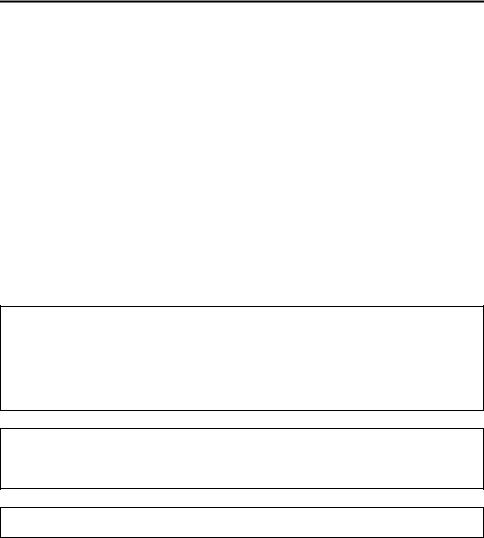
A Word to Mazda Owners
Thank you for choosing a Mazda. We at Mazda design and build vehicles with complete customer satisfaction in mind.
To help ensure enjoyable and trouble-free operation of your Mazda, read this manual carefully and follow its recommendations.
An Authorized Mazda Dealer knows your vehicle best. So when maintenance or service is necessary, that’s the place to go.
Our nationwide network of Mazda professionals is dedicated to providing you with the best possible service.
We assure you that all of us at Mazda have an ongoing interest in your motoring pleasure and in your full satisfaction with your Mazda product.
Mazda Motor Corporation
HIROSHIMA, JAPAN
Important Notes About This Manual
Keep this manual in the glove box as a handy reference for the safe and enjoyable use of your Mazda. Should you resell the vehicle, leave this manual with it for the next owner.
All specifications and descriptions are accurate at the time of printing. Because improvement is a constant goal at Mazda, we reserve the right to make changes in specifications at any time without notice and without obligation.
Air Conditioning and the Environment
Your Mazda’s genuine air conditioner is filled with HFC134a (R134a), a refrigerant that has been found not to damage the earth’s ozone layer. If the air conditioner does not operate properly, consult an Authorized Mazda Dealer.
Please be aware that this manual applies to all models, equipment and options. As a result, you may find some explanations for equipment not installed on your vehicle.
©2003 Mazda Motor Corporation Printed in Japan Aug. 2003(Print1)

How to Use This Manual
We want to help you get the most driving pleasure from your vehicle. Your owner’s manual, when read from cover to cover, can do that in many ways.
Illustrations complement the words of the manual to best explain how to enjoy your Mazda. By reading your manual, you can find out about the features, important safety information, and driving under various road conditions.
The above symbol in this manual means "Do not do this " or "Do not let this happen".
Index: A good place to start is the Index, an alphabetical listing of all information in your manual.
You’ll find several WARNINGs, CAUTIONs, and NOTEs in the manual.
 WARNING
WARNING
A WARNING indicates a situation in which serious injury or death could result if the warning is ignored.
 CAUTION
CAUTION
A CAUTION indicates a situation in which bodily injury or damage to your vehicle, or both, could result if the caution is ignored.
NOTE
A NOTE provides information and sometimes suggests how to make better use of your vehicle.
The above symbol, located on some parts of the vehicle, indicates that this manual contains information related to the part.
Please refer to the manual for a detailed explanation.

Table of Contents
Your Vehicle at a Glance |
1 |
Interior, exterior views and part identification of your Mazda.
Essential Safety Equipment |
2 |
Use of safety equipment, including seats, seat belt system, SRS air bags and child-restraint systems.
Knowing Your Mazda |
3 |
Explanation of basic operations and controls; opening/closing and adjustment of various parts.
Before Driving Your Mazda |
4 |
Important information about driving your Mazda. |
|
|
|
|
|
Driving Your Mazda |
5 |
Explanation of instruments and controls. |
|
|
|
|
|
Interior Comfort |
6 |
Use of various features for drive comfort, including climate control and audio |
|
|
|
system. |
|
|
|
In Case of an Emergency |
7 |
Helpful information on what to do in an emergency. |
|
|
|
|
|
Maintenance and Care |
8 |
How to keep your Mazda in top condition. |
|
|
|
|
|
Customer Information and Reporting Safety Defects |
9 |
Important consumer information including warranties and add-on equipment. |
|
|
|
|
|
Specifications |
10 |
Technical information about your Mazda. |
|
|
Index |
11 |
|
|
|
1 |
Your Vehicle at a Glance |
|
|
|
|
|
|
|
|
|
|
|
Interior, exterior views and part identification of your Mazda. |
|
|
|
|
|
|
|
|
|
|
|
Dashboard Overview .................................................................... |
1-2 |
|
|
|
|
Interior Overview .......................................................................... |
1-3 |
|
|
|
|
Exterior Overview ......................................................................... |
1-4 |
|
|
1-1
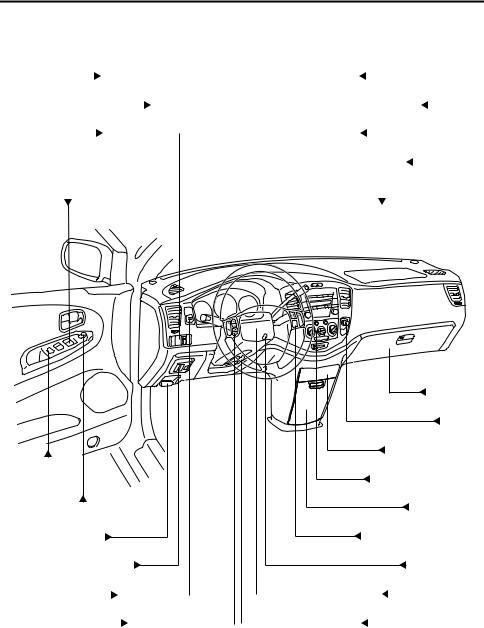
Your Vehicle at a Glance
Dashboard Overview
Instrument cluster |
|
|
|
|
|
|
|
|
|
Wiper and washer lever |
|||||
(page 5-20) |
|
|
|
|
|
|
|
|
|
(page 5-36) |
|||||
Lighting control/Turn signals |
|
|
|
|
|
|
|
|
|
|
|
|
Shift lever |
||
(page 5-34) |
|
|
|
|
|
|
|
|
|
|
(page 5-9) |
||||
TCS OFF switch* |
|
|
|
|
|
|
|
|
|
Hazard warning flasher |
|||||
(page 5-18) |
|
|
|
|
|
|
|
|
|
|
(page 5-39) |
||||
|
|
|
|
|
|
|
|
|
|
|
|
|
|
Audio system |
|
|
|
|
|
|
|
|
|
|
|
|
|
|
|
||
|
|
|
|
|
|
|
|
|
|
|
|
|
|
|
(page 6-14) |
Power window switches* |
|
|
|
|
|
|
|
Passenger-side air bag |
|||||||
(page 3-19) |
|
|
|
|
|
|
|
|
|
|
(page 2-56) |
||||
|
|
|
|||||||||||||
|
|
|
|
|
|
|
|
|
|
|
|
|
|
|
|
|
|
|
|
|
|
|
|
|
|
|
|
|
|
|
|
|
|
|
|
|
|
|
|
|
|
|
|
|
|
|
|
|
|
|
|
|
|
|
|
|
|
|
|
|
|
|
|
|
|
|
|
|
|
|
|
|
|
|
|
|
|
|
|
|
Glove box |
|
(page 6-50) |
|
Lighter |
|
(page 6-44) |
|
Cup holder/Ashtray |
Power window |
(page 6-46)/(page 6-45) |
lock switch* |
Climate control system |
(page 3-21) |
(page 6-2) |
Power door lock switch* |
Front console |
(page 3-8) |
(page 6-50) |
Hood release handle |
Cruise control switches* |
(page 3-24) |
(page 5-14) |
Power sliding door switch* |
Ignition switch |
(page 3-13) |
(page 5-2) |
Outside mirror switch |
|
|
|
|
|
Driver-side air bag |
||
|
|
|
|
|
||||
(page 3-33) |
|
|
|
(page 2-56) |
||||
Audio control switches* |
|
|
|
|
|
Tilt wheel release lever |
||
|
|
|
|
|||||
(page 6-38) |
|
|
|
(page 3-33) |
||||
1-2 *Some models.
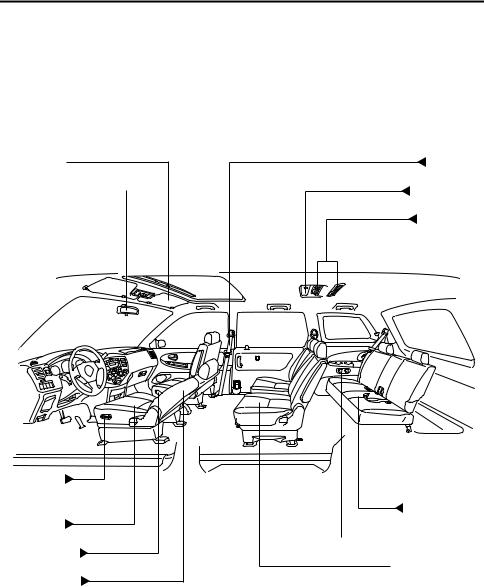
Your Vehicle at a Glance
Interior Overview
Sunvisors 
(page 6-41)
Rearview mirror 
(page 3-34)
Power seat |
switches |
(page 2-8) |
Front seats |
(page 2-3) |
Parking brake |
(page 5-5) |
Side air bags* |
(page 2-56) |
Seat belts |
(page 2-30) |
Interior light |
(page 6-42) |
Rear vents* |
(page 6-10) |
Third-row seat
(page 2-20)
 Rear climate control panel*
Rear climate control panel*
(page 6-12)
 Second-row seat
Second-row seat
(page 2-13)
*Some models. |
1-3 |
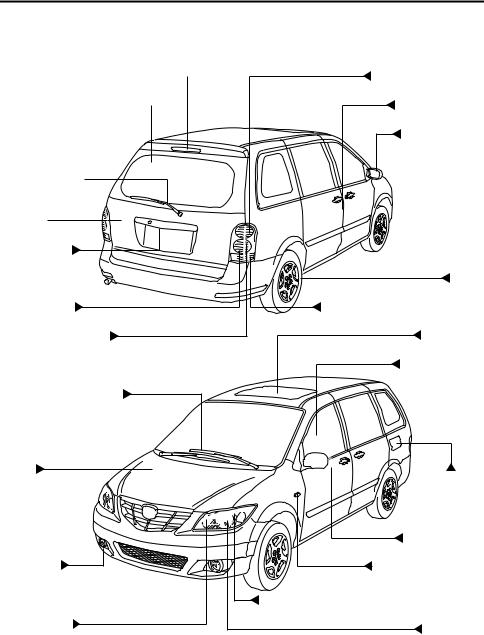
Your Vehicle at a Glance
Exterior Overview
High-mount brake light 
(page 8-31)
Rear window defroster 
(page 5-38)
Rear windshield  wiper blades
wiper blades
(page 8-22)
Liftgate 
(page 3-18)
Brake lights/Taillights |
(page 8-31) |
Child safety lock |
(page 3-12) |
Outside mirrors |
(page 3-33) |
License plate |
|
lights |
|
(page 8-31) |
Tires |
|
(page 8-27) |
Reverse lights |
Taillights/Rear side-marker lights |
(page 8-31) |
(page 8-31) |
Rear turn signal lights |
Moonroof* |
(page 8-31) |
(page 3-25) |
|
Power windows |
|
(page 3-19) |
Windshield wiper blades |
|
(page 8-20) |
|
Hood |
Fuel-filler lid |
|
(page 3-24) |
||
(page 3-23) |
||
|
||
|
Doors and keys |
|
|
(page 3-2) |
|
Fog lights* |
Side turn signal lights |
|
(page 8-31) |
(page 8-31) |
|
|
Front turn signal lights/Front side-marker lights |
|
Parking lights |
(page 8-31) |
|
Headlights |
||
(page 8-31) |
||
(page 8-31) |
||
|
1-4 *Some models.
|
2 |
Essential Safety Equipment |
|
|
|
Use of safety equipment, including seats, seat belt system, SRS air bags and child-restraint systems.
................................................................................................Seats |
2-2 |
|
....................................................................Seat Arrangements |
2-2 |
|
Front Seats (Manually Operated Seats) ..................................... |
2-3 |
|
Front Seats (Electrically Operated Seats) .................................. |
2-8 |
|
Second-Row Seats ................................................................... |
2-13 |
|
Third-Row Seat ....................................................................... |
2-20 |
|
Flat Folding ............................................................................. |
2-28 |
|
Seat Belt Systems ......................................................................... |
2-30 |
|
Seat Belt Precautions ............................................................... |
2-30 |
|
3-Point Type Seat Belt ............................................................. |
2-33 |
|
Front Seat Belt Pretensioner and Load Limiting Systems ...... |
2-35 |
|
2-Point Type Seat Belt ............................................................. |
2-37 |
|
Seat Belt Extender ................................................................... |
2-39 |
|
Seat Belt Warning Light .......................................................... |
2-40 |
|
Seat Belt Warning Beep ........................................................... |
2-40 |
|
Child Restraint ............................................................................ |
2-41 |
|
Child Restraint Precautions ..................................................... |
2-41 |
|
Installing Child-Restraint Systems .......................................... |
2-45 |
|
LATCH Child-Restraint Systems ............................................ |
2-53 |
|
SRS Air Bags ............................................................................... |
2-56 |
|
Supplemental Restraint Systems (SRS) Precautions ............... |
2-56 |
|
Supplemental Restraint System Components .......................... |
2-60 |
|
How the Air Bags Work .......................................................... |
2-63 |
|
2-1
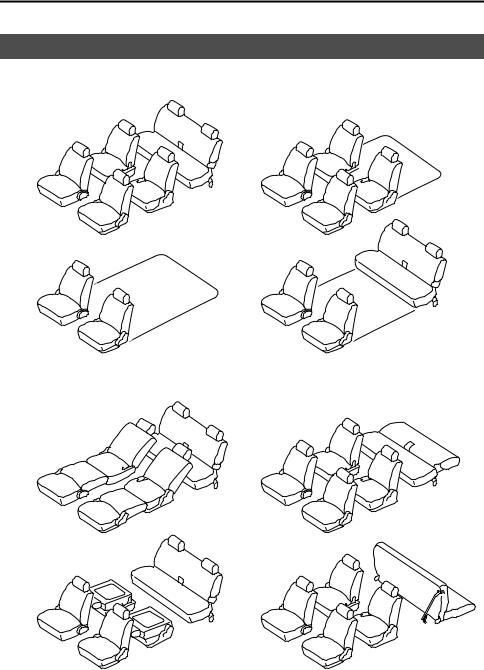
Essential Safety Equipment
Seats
Seat Arrangements
Road positions (while driving)
Non-road positions (Parking/Camping)
2-2
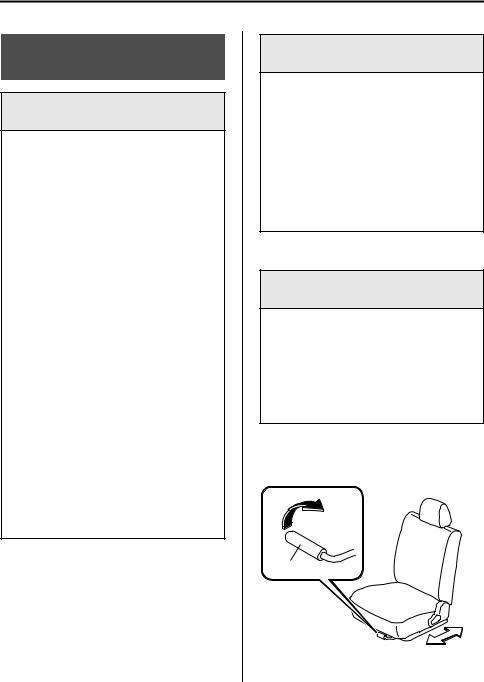
Essential Safety Equipment
Seats
Front Seats (Manually
Operated Seats)
 WARNING
WARNING
Modification of the Front Seats: Modifying or replacing the front seats such as replacing the upholstery or loosening any bolts is dangerous. The front seats contain air bag components essential to the supplemental restraint system. Such modification could damage the supplemental restraint system and result in serious injury. Consult an Authorized Mazda Dealer if there is any need to remove or reinstall the front seats.
Damaged Front Seats:
Driving with damaged front seats is dangerous. A collision, even one not strong enough to inflate the air bags, could damage the front seats which contain essential air bag components. If there was a subsequent collision, the air bag may not deploy which could lead to injuries. Always have an Authorized Mazda Dealer inspect the front seats, front seat belt pretensioners and air bags after a collision.
 WARNING
WARNING
Securing the Seats:
Adjustable seats and seatbacks that are not securely locked are dangerous. In a sudden stop or collision, the seat or seatback could move, causing injury. Make sure the adjustable components of the seat are locked in place by attempting to slide the seat forward and backward and rocking the seatback.
▼Seat Slide
 WARNING
WARNING
Driver’s Seat Adjustment: Adjusting the driver’s seat while the vehicle is moving is dangerous. The
driver could lose control of the vehicle and have an accident. Adjust the driver’s seat only when the vehicle is stopped.
To move a seat forward or backward, raise the lever and slide the seat to the desired position and release the lever.
Lever
2-3
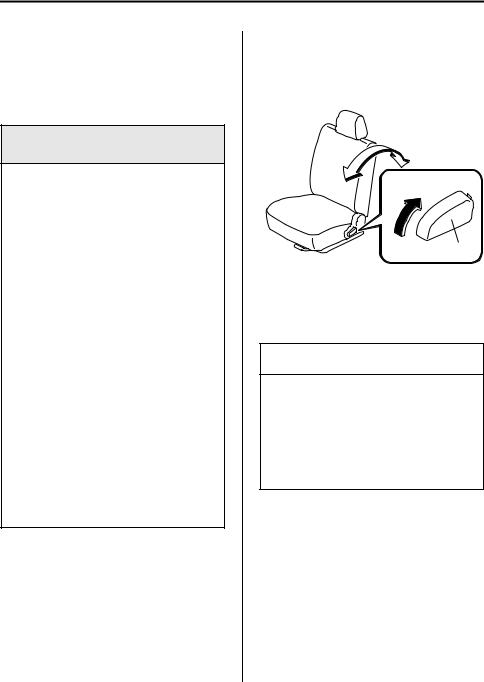
Essential Safety Equipment
Seats
Make sure the lever returns to its original position and the seat is locked in place by attempting to push it forward and backward.
▼Seat Recline
 WARNING
WARNING
Reclining:
Sitting in a reclined position while the vehicle is moving is dangerous because you don’t get the full protection from seat belts. During sudden braking or a collision, you can slide under the lap belt and suffer serious internal injuries. For maximum protection, sit well back and upright.
Unlocked Seatback:
The seatback plays an important role in your protection in a vehicle. Leaving the seatback unlocked is dangerous as it can allow passengers to be ejected or thrown around and baggage to strike occupants in a sudden stop or collision, resulting in severe injury. After adjusting the seatback at any time, even when there are no other passengers, rock the seatback to make sure it is locked in place.
To change the seatback angle, lean forward slightly while raising the lever. Then lean back to the desired position and release the lever.
Lever
Make sure the lever returns to its original position and the seatback is locked in place by attempting to push it forward and backward.
 CAUTION
CAUTION
When returning a rear-reclined seatback to its upright position, make sure you support the seatback while operating the seatback lever. If the seatback is not supported, it will flip forward suddenly and could cause injury.
2-4
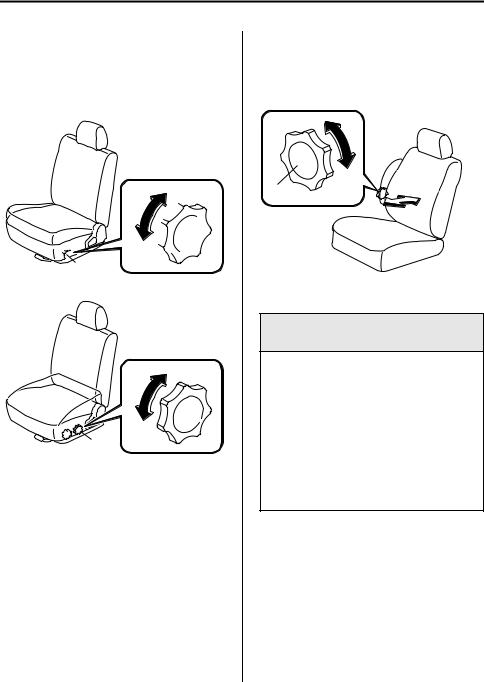
Essential Safety Equipment
Seats
▼Height Adjustment (Driver’s Seat)
The seat-bottom angle can be adjusted by rotating the dial.
Front of seat bottom
Up
 Down
Down
Dial
Rear of seat bottom
Up
Down
Dial
▼Lumber Support Adjustment (Driver’s Seat)*
The amount of lumber support can be adjusted by rotating dial.
Dial
▼Head Restraint
 WARNING
WARNING
Head Restraints Adjustment: Driving with the head restraints adjusted too low or removed is dangerous. With no support behind your head, your neck could be seriously injured in a collision. Always drive with the head restraints inserted when seats are being used and make sure they are properly adjusted.
*Some models. |
2-5 |
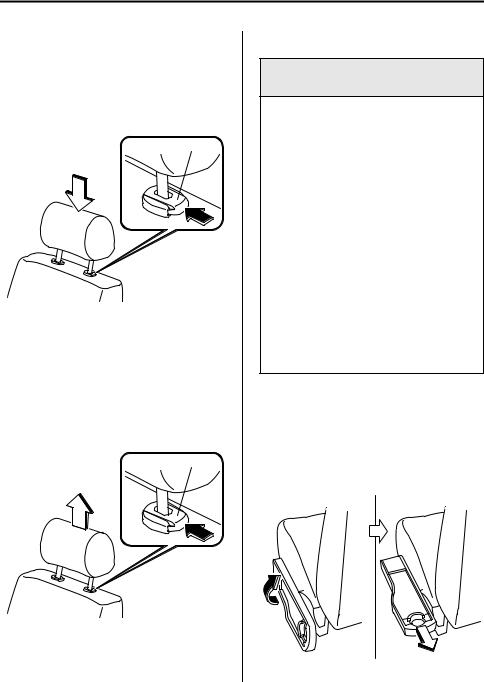
Essential Safety Equipment
Seats
Height adjustment
To raise a head restraint, pull it up to the desired position.
To lower the head restraint, press the stopcatch release, then push the head restraint down.
Stop-catch release
Adjust the head restraint so that the top is parallel with the top of the passenger’s ears, never the passenger’s neck.
Removal
To remove the head restraint, press the stop-catch release, then pull up on the head restraint.
Stop-catch release
▼Front Passenger Seat Side Table
 WARNING
WARNING
Using Seat Side Table While Vehicle is Moving:
Using the seat side table while the vehicle is moving is dangerous. Hot liquids could cause scalding if spilled, or objects could fall causing injury. Do not use the seat side table while the vehicle is moving.
Adjusting Front Passenger Seat While Seat Side Table is in Use: Adjusting the front passenger seat forward or rearward while the seat side table is in use is dangerous. Hot liquids could cause scalding if spilled, or objects could fall causing injury. Do not adjust the front passenger seat while the seat side table is in use.
The pull-up table on the side of the front passenger seat is collapsible. The table can be used when the vehicle is safely parked.
Pull up the table to use it. After pulling the table up, push the table downward and verify that it is locked.
2-6
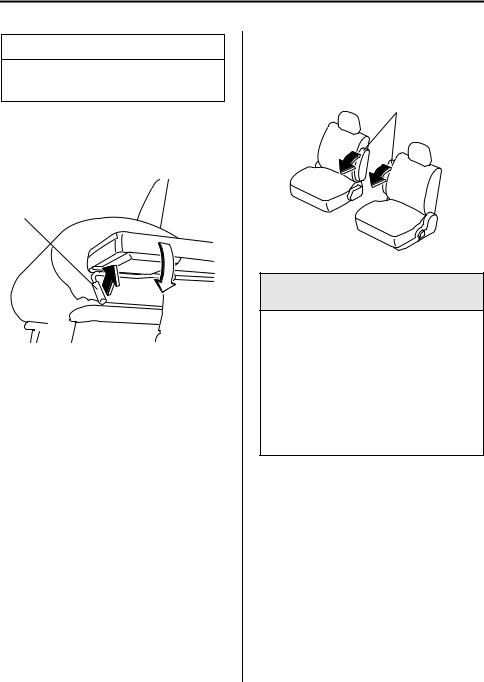
Essential Safety Equipment
Seats
NOTE
The table can be expanded rearward by pulling out the rear end.
When collapsing the table, pull the lever under the table. After the table is collapsed, press the table surface to lock it in place.
Lever
▼Armrest
The armrest can be used or placed upright.
Armrests
 WARNING
WARNING
Positioning the Shoulder Belt Over the Armrest:
Positioning the shoulder portion of a front seat belt over the armrest is dangerous as it cannot provide adequate protection in a collision and could result in serious injuries. Never position the shoulder portion of a front seat belt over the armrest.
2-7
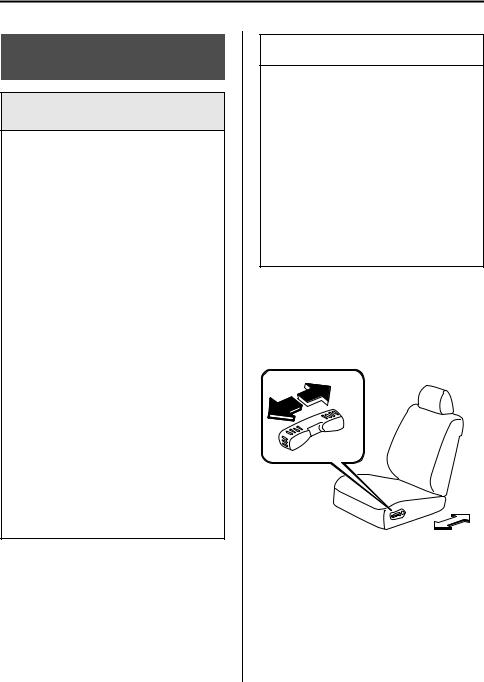
Essential Safety Equipment
Seats
Front Seats (Electrically
Operated Seats)
 WARNING
WARNING
Modification of the Front Seats: Modifying or replacing the front seats such as replacing the upholstery or loosening any bolts is dangerous. The front seats contain air bag components essential to the supplemental restraint system. Such modification could damage the supplemental restraint system and result in serious injury. Consult an Authorized Mazda Dealer if there is any need to remove or reinstall the front seats.
Damaged Front Seats:
Driving with damaged front seats is dangerous. A collision, even one not strong enough to inflate the air bags, could damage the front seats which contain essential air bag components. If there was a subsequent collision, the air bag may not deploy which could lead to injuries. Always have an Authorized Mazda Dealer inspect the front seats, front seat belt pretensioners and air bags after a collision.
 CAUTION
CAUTION
•The seat-bottom power adjustment is operated by motors. Avoid extended operation because excessive use can damage the motors.
•To prevent the battery from running down, avoid using the power adjustment when the engine is stopped. The adjuster uses a large amount of electric power.
•Don’t use the switch to make more than one adjustment at a time.
▼Seat Slide (Driver’s Seat)
To slide the seat, move the slide lifter switch on the outside of the seat to the front or back and hold it. Release the switch at the desired position.
2-8
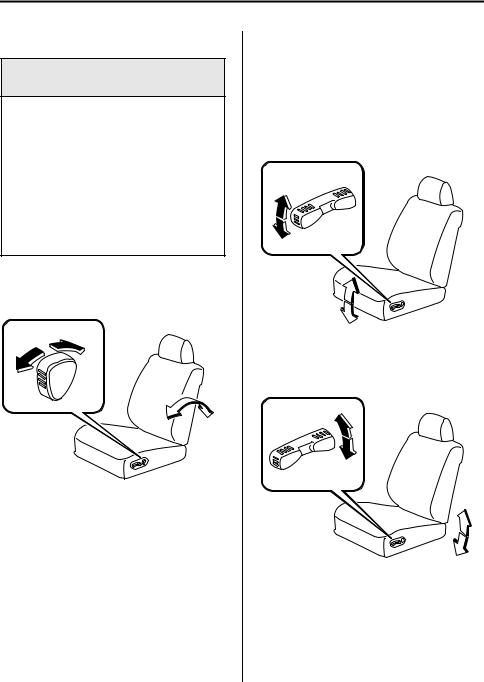
Essential Safety Equipment
Seats
▼Seat Recline (Driver’s Seat)
 WARNING
WARNING
Reclining:
Sitting in a reclined position while the vehicle is moving is dangerous because you don’t get the full protection from seat belts. During sudden braking or a collision, you can slide under the lap belt and suffer serious internal injuries. For maximum protection, sit well back and upright.
Change the seatback angle by pressing the front or rear side of the reclining switch. Release the switch at the desired position.
▼Height Adjustment (Driver’s Seat)
Front height adjustment
To adjust the front height of the seatbottom, raise or lower the front of the slide lifter switch on the left side of the seat.
Rear height adjustment
Raise or lower the back of the switch to adjust the rear height of the seat-bottom.
2-9
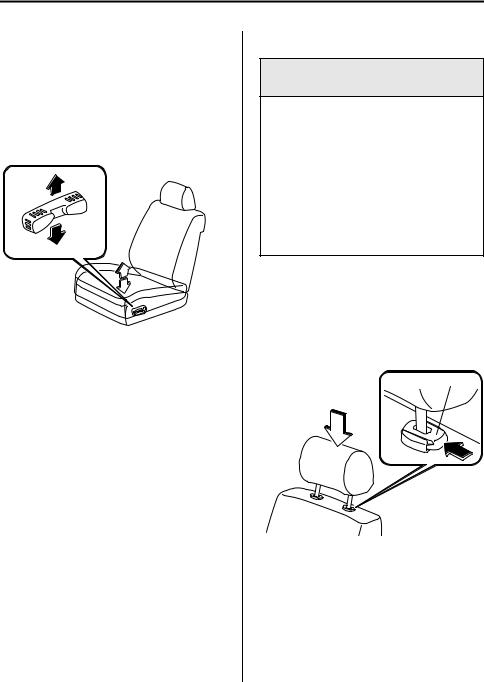
Essential Safety Equipment
Seats
Height adjustment
Raise the seat-bottom by pulling up on the center of the switch. Release the switch at the desired position.
Lower the seat-bottom by pressing down on the center of the switch. Release the switch at the desired position.
▼Head Restraint
 WARNING
WARNING
Head Restraints Adjustment: Driving with the head restraints adjusted too low or removed is dangerous. With no support behind your head, your neck could be seriously injured in a collision. Always drive with the head restraints inserted when seats are being used and make sure they are properly adjusted.
Height adjustment
To raise a head restraint, pull it up to the desired position.
To lower the head restraint, press the stopcatch release, then push the head restraint down.
Stop-catch release
Adjust the head restraint so that the top is parallel with the top of the passenger’s ears, never the passenger’s neck.
2-10
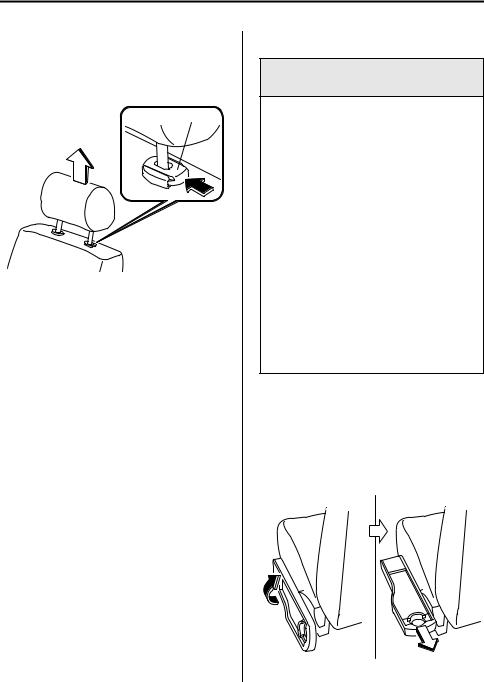
Essential Safety Equipment
Seats
Removal
To remove the head restraint, press the stop-catch release, then pull up on the head restraint.
Stop-catch release
▼Front Passenger Seat Side Table
 WARNING
WARNING
Using Seat Side Table While Vehicle is Moving:
Using the seat side table while the vehicle is moving is dangerous. Hot liquids could cause scalding if spilled, or objects could fall causing injury. Do not use the seat side table while the vehicle is moving.
Adjusting Front Passenger Seat While Seat Side Table is in Use: Adjusting the front passenger seat forward or rearward while the seat side table is in use is dangerous. Hot liquids could cause scalding if spilled, or objects could fall causing injury. Do not adjust the front passenger seat while the seat side table is in use.
The pull-up table on the side of the front passenger seat is collapsible. The table can be used when the vehicle is safely parked.
Pull up the table to use it. After pulling the table up, push the table downward and verify that it is locked.
2-11
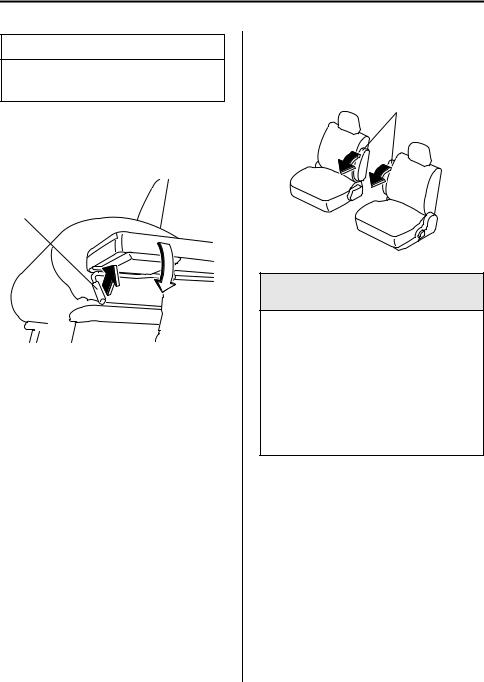
Essential Safety Equipment
Seats
NOTE
The table can be expanded rearward by pulling out the rear end.
When collapsing the table, pull the lever under the table. After the table is collapsed, press the table surface to lock it in place.
Lever
▼Armrest
The armrest can be used or placed upright.
Armrests
 WARNING
WARNING
Positioning the Shoulder Belt Over the Armrest:
Positioning the shoulder portion of a front seat belt over the armrest is dangerous as it cannot provide adequate protection in a collision and could result in serious injuries. Never position the shoulder portion of a front seat belt over the armrest.
2-12
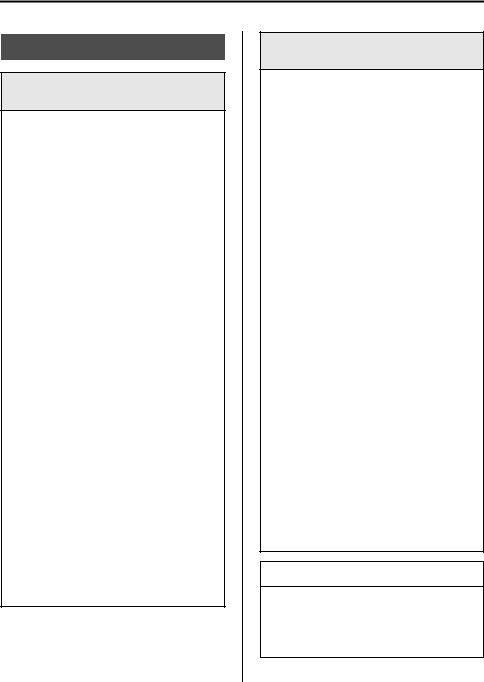
Essential Safety Equipment
Seats
Second-Row Seats
 WARNING
WARNING
Stacking Cargo:
Stacking luggage or other cargo higher than the seatback is dangerous. During a sudden stop or collision, objects can fly around and become projectiles that could hit and injure passengers. Don’t stack cargo higher than the seatback.
Not Securing Luggage and Cargo: Not securing cargo while driving is dangerous as they could move or be crushed in sudden braking or a collision and cause injury. Make sure luggage and cargo is secured before driving.
Securing Seats:
Adjustable seats that are not securely latched are dangerous. In a sudden stop or collision, the seat or seatback could move, causing injury. Make sure the adjustable components of the seat are locked in place by attempting to slide the seat forward and backward and rocking the seatback.
Seat Adjustment:
Adjusting the seat while the vehicle is moving is dangerous. Sudden braking or a collision could cause serious injury. Adjust the seat only when the vehicle is stopped.
 WARNING
WARNING
Unlocked Seatback:
The seatback plays an important role in your protection in a vehicle. Leaving the seatback unlocked is dangerous as it can allow passengers to be ejected or thrown around and baggage to strike occupants in a sudden stop or collision, resulting in severe injury. After adjusting the seatback at any time, even when there are no other passengers, rock the seatback to make sure it is locked in place.
Passenger on the Folded Seatback: Driving with a passenger on the folded seatback is dangerous. Allowing a child to sit on the folded seatback while the vehicle is moving is particularly dangerous. During sudden braking or even a minor collision, a child not restrained in a proper seat or child-restraint system and seat belt could be thrown forward, back or even out of the car resulting in serious injuries or death. The child or other objects in the cargo area could be thrown into other occupants and cause serious injury. Never allow a passenger to sit or stand on the folded seatback while the vehicle is moving.
NOTE
When returning a second-row seat to its original position, also replace the seat belt to its normal position. Verify that the seat belt pulls and retracts.
2-13
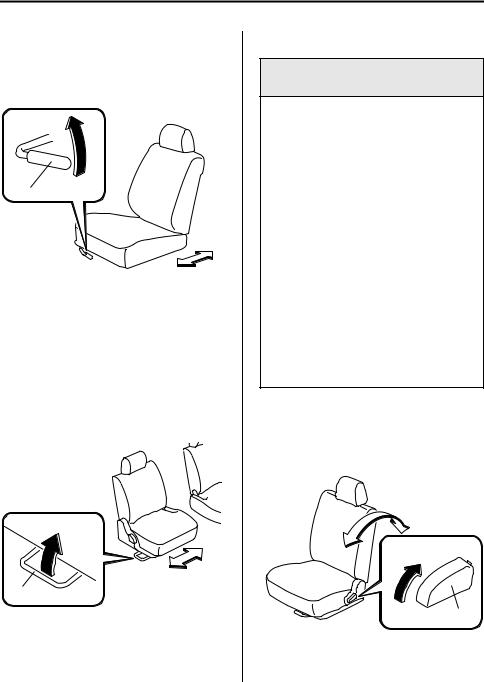
Essential Safety Equipment
Seats
▼Seat Slide
To move the seat forward or backward, raise the lever and slide the seat to the desired position and release the lever.
Lever
Make sure the lever returns to its original position and the seat is locked in place by attempting to push it forward and backward.
▼Side-Sliding Seat (right side)
The second-row seats can be put together and used as a bench seat. Raise the side seat-slide lever and slide the seat sideways.
▼Seat Recline
 WARNING
WARNING
Reclining:
Sitting in a reclined position while the vehicle is moving is dangerous because you don’t get the full protection from seat belts. During sudden braking or a collision, you can slide under the lap belt and suffer serious internal injuries. For maximum protection, sit well back and upright.
Reclining the Second-Row Seatback: Reclining the second-row seatback when the third-row seat is occupied is dangerous. The second-row seatback may hit and injure the occupants in the third-row seat. Don’t recline the second-row seatback when the thirdrow seat is occupied.
To change the seatback angle, lean forward slightly while raising the lever. Then lean back to the desired position and release the lever.
Side seat-slide lever
Lever
Make sure the lever returns to its original position and the seat is locked in place by attempting to push it from side to side.
2-14
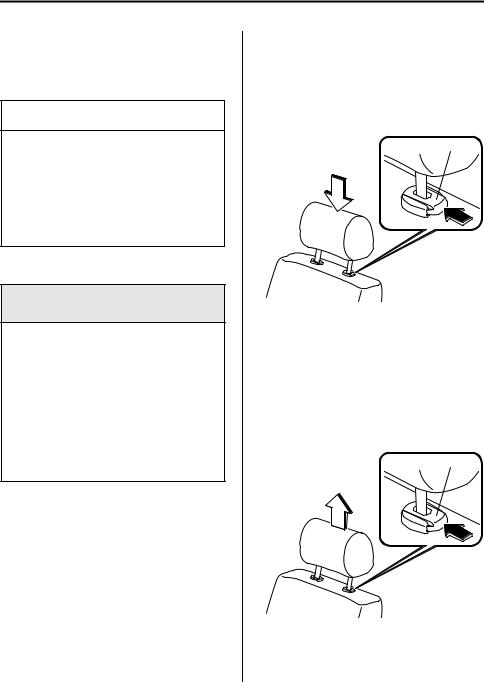
Essential Safety Equipment
Seats
Make sure the lever returns to its original position and the seatback is locked in place by attempting to push it forward and backward.
 CAUTION
CAUTION
When returning a rear-reclined seatback to its upright position, make sure you support the seatback while operating the seatback lever. If the seatback is not supported, it will flip forward suddenly and could cause injury.
▼Head Restraint
 WARNING
WARNING
Head Restraints Adjustment: Driving with the head restraints adjusted too low or removed is dangerous. With no support behind your head, your neck could be seriously injured in a collision. Always drive with the head restraints inserted when seats are being used and make sure they are properly adjusted.
Height adjustment
To raise a head restraint, pull it up to the desired position.
To lower the head restraint, press the stopcatch release, then push the head restraint down.
Stop-catch release
Adjust the head restraint so that the top is parallel with the top of the passenger’s ears, never the passenger’s neck.
Removal
To remove the head restraint, press the stop-catch release, then pull up on the head restraint.
Stop-catch release
2-15
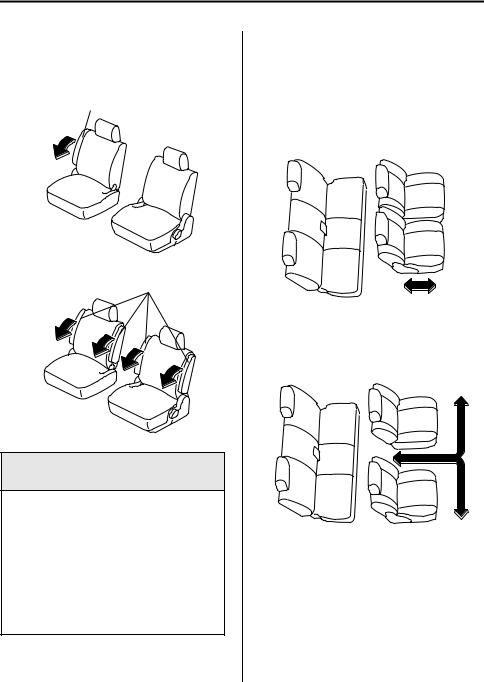
Essential Safety Equipment
Seats
▼Armrest
The armrest can be used or placed upright.
Type A |
Armrest |
Type B |
Armrest |
 WARNING
WARNING
Positioning the Shoulder Belt Over the Armrest:
Positioning the shoulder portion of a second-row seat belt over the armrest is dangerous as it cannot provide adequate protection in a collision and could result in serious injuries. Never position the shoulder portion of a second-row seat belt over the armrest.
▼Third-Row Seat Access
Access to the third-row seat via the sliding door
When the second-row seats are together, move along the path between the sliding door and the side sliding seat.
When the second-row seats are separated, pass between them and move to the rear of the vehicle.
2-16
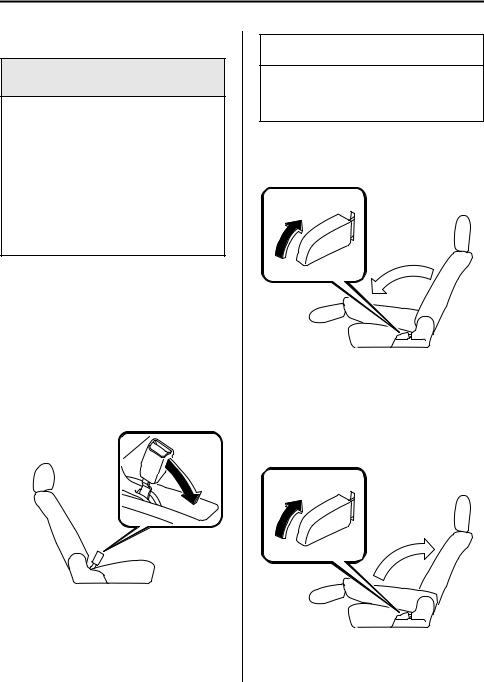
Essential Safety Equipment
Seats
▼Folding the Second-Row Seats
 WARNING
WARNING
Using Folded Seatback as a Table While the Vehicle is Moving: Using the folded seatback as a table while driving is dangerous. During
sudden braking or a collision, objects placed on the folded seatback could become projectiles that could hit and injure someone. Never use the folded seat as a table while the vehicle is moving.
The second-row seatbacks can be folded down and used as tables when the vehicle is not moving.
To fold the seatback
1.If your vehicle is equipped with an armrest, return the armrest to the upright position.
2.Put the buckle in the pocket of the seat bottom.
 CAUTION
CAUTION
Lowering the seatback without stowing the seat belt buckle could damage the seatback.
3.Raise the reclining lever and lower the seatback forward. Make sure the seatback is locked.
To return the seatback to the upright position
Raise the reclining lever and lift the seatback upright. Attempt to move the seatback forward and backward to make sure it is locked.
2-17
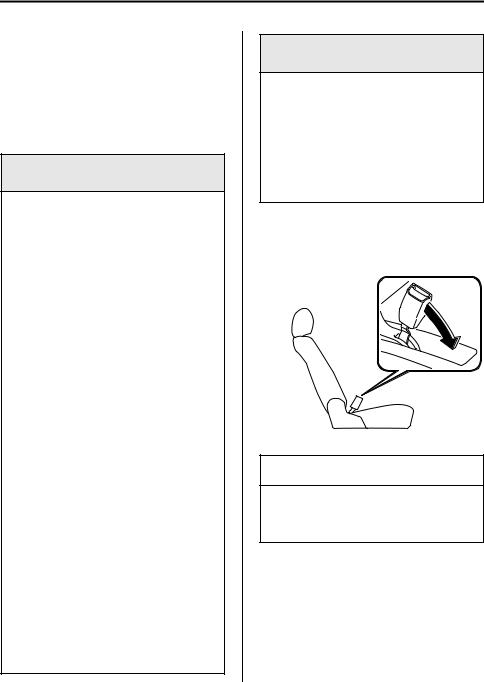
Essential Safety Equipment
Seats
▼Removal of Second-Row Seats
The second-row seats can be removed to create a more comfortable space between the third-row and front seats. Additional cargo space is available with the removal of the second-row seats and stowing of the third-row seat.
 WARNING
WARNING
Seat Removal or Installation While Vehicle is Moving or on a Slope: Removing or installing the secondrow seats while the vehicle is moving or on a slope is dangerous. The seats are heavier than they appear and could suddenly detach causing serious injury. Remove or install the seats with the vehicle parked on a level surface.
Riding on the Floor Space:
Riding on the floor space created by the removal of the second-row seat is dangerous. Sudden braking or a collision could cause serious injury. Do not sit or lie in the floor space for the second-row seat while the vehicle is moving. Never ride in a vehicle where you can’t sit in the seat and wear the seat belt.
Pinching Fingers or Hands: Placing your hands around the seat anchors when removing or installing the second-row seats is dangerous. You could pinch your hands or fingers between the seat anchor and the seat. Hold the edge of the seat when lowering it into place. Never place your hands between the seat anchor and the seat.
 WARNING
WARNING
Lifting the Seat-Anchor Bar: Lifting the seat-anchor bar without firmly supporting the seat with your hand is dangerous. Lifting the seat unlocks the front clamps automatically and could cause the seat to fall. Support the seat firmly while lifting the seat-anchor bar.
To remove the seat
1.Put the buckle in the pocket of the seat bottom.
 CAUTION
CAUTION
Lowering the seatback without stowing the seat belt buckle could damage the seatback.
2.Lower the head restraint all the way down.
3.Slide the seat all the way back.
2-18
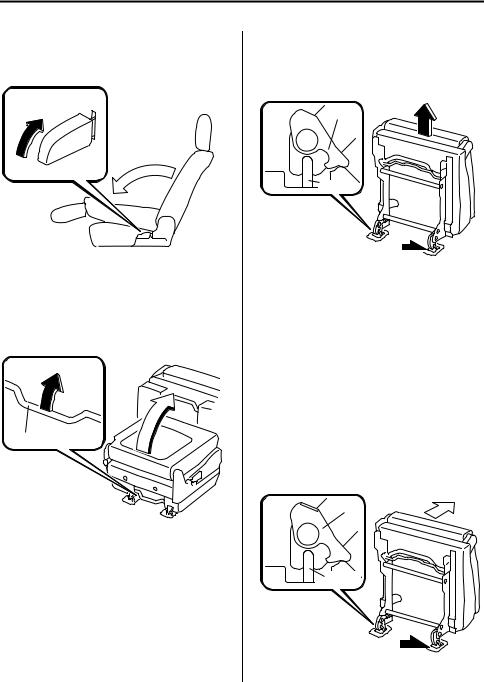
Essential Safety Equipment
Seats
4.Raise the reclining lever and lower the seatback forward.
Make sure the seatback is locked.
5.Work only on one seat at a time to avoid one seat falling while working on another.
6.Lift and hold the seat-anchor bar and raise the entire seat up and forward.
Seat-anchor bar
7.The seat is heavier than it looks, carefully pull up and detach the seat. Get assistance to lift it out of the vehicle.
 Clamp
Clamp
Loops
To install the seat
1.First identify which seat fits which position by verifying that the seat belt buckles are located nearest the center of the vehicle.
2.Align the clamps on the front underside of the seat with the forward loop anchors on the floor and support the seat so that it doesn’t fall (the rear portion of the seat cannot be mounted first). The clamps on the front of the seat automatically lock into the floor loop anchors after lowering the seat.
Clamp |
Front |
|
Loops
2-19
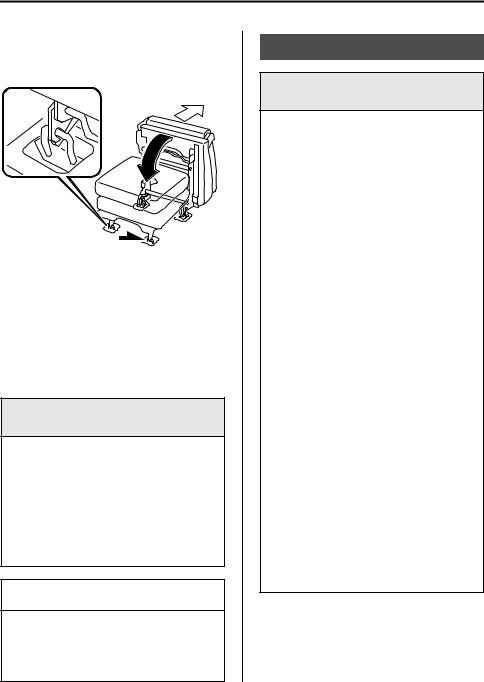
Essential Safety Equipment
Seats
3.Supporting the seat with your hands, slowly lower the seat rearwards to lock it in place.
Front
4.Raise the reclining lever and lift the seatback upright. Attempt to move the seatback forward and backward to make sure it is locked.
5.Buckle the seat belts once just to confirm the seat belt buckles are inboard which means each seat is on the correct side of the vehicle.
 WARNING
WARNING
Unsecured Seat:
Driving with the seat unsecured is dangerous. The seat may become detached while the vehicle is moving causing serious injury. After installing the seat, push it forward and backward to make sure it is securely locked.
 CAUTION
CAUTION
Do not move the side seat-slide lever with the seat removed. The lever could be damaged resulting in loss of functionality.
Third-Row Seat
 WARNING
WARNING
Stacking Cargo:
Stacking luggage or other cargo higher than the seatback is dangerous. During a sudden stop or collision, objects can fly around and become projectiles that could hit and injure passengers. Don’t stack cargo higher than the seatback.
Not Securing Luggage and Cargo: Not securing cargo while driving is dangerous as they could move or be crushed in sudden braking or a collision and cause injury. Make sure luggage and cargo is secured before driving.
Securing Seats:
Adjustable seats that are not securely latched are dangerous. In a sudden stop or collision, the seat or seatback could move, causing injury. Make sure the adjustable components of the seat are locked in place by attempting to rock the seatback.
Seat Adjustment:
Adjusting the seat while the vehicle is moving is dangerous. Sudden braking or a collision could cause serious injury. Adjust the seat only when the vehicle is stopped.
2-20
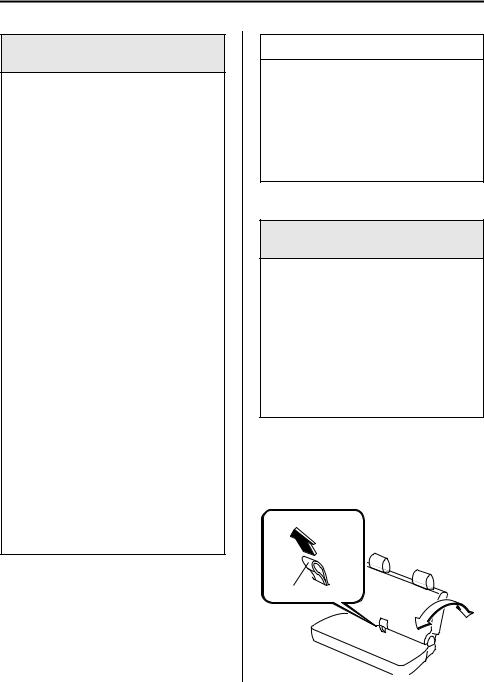
Essential Safety Equipment
Seats
 WARNING
WARNING
Unlocked Seatback:
The seatback plays an important role in your protection in a vehicle. Leaving the seatback unlocked is dangerous as it can allow passengers to be ejected or thrown around and baggage to strike occupants in a sudden stop or collision, resulting in severe injury. After adjusting the seatback at any time, even when there are no other passengers, rock the seatback to make sure it is locked in place.
Passenger on the Folded Seatback: Driving with a passenger on the folded seatback is dangerous. Allowing a child to sit up on the folded seatback while the vehicle is moving is particularly dangerous. In a sudden stop or even a minor collision, a child not in a proper seat or child-restraint system and seat belt could be thrown forward, back or even out of the car resulting in serious injuries or death. The child or other objects in the baggage area could be thrown into other occupants and cause serious injury. Never allow a passenger to sit or stand on the folded seatback while the vehicle is moving.
NOTE
•The third-row seat cannot be removed.
•When returning the third-row seat to its original position, also place the seat belt in its normal position. Verify that the seat belt pulls and retracts.
▼Seat Recline
 WARNING
WARNING
Reclining:
Sitting in a reclined position while the vehicle is moving is dangerous because you don’t get the full protection from seat belts. During sudden braking or a collision, you can slide under the lap belt and suffer serious internal injuries. For maximum protection, sit well back and upright.
To change seatback angle, lean forward slightly while pulling the flat-folding strap. Then lean back to the desired position and release the strap. Make sure the seat is securely latched.
Flat-folding strap
2-21
